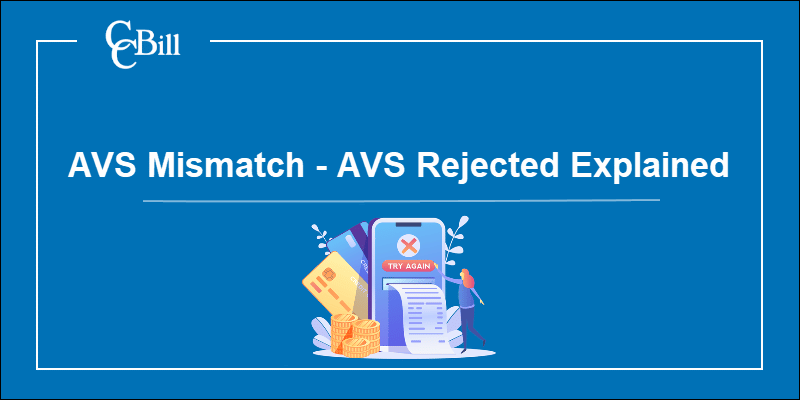Introduction
Merchants use a variety of fraud prevention tools to protect themselves and their customers against fraud. One commonly used tool that is particularly useful in preventing address fraud is the Address Verification System (AVS).
AVS determines the risk level of a transaction by comparing the delivery address to the address associated with the customer’s payment method. If the addresses match, AVS allows the transaction to be completed. However, if AVS finds a mismatch, the suspicious transaction can be accepted, rejected, or manually inspected. But is every AVS mismatch a cause for alarm?
This guide explains what an AVS mismatch error is and how to fix it.

What Does an AVS Mismatch Mean?
An AVS mismatch happens when the billing information of a transaction does not match the information the issuing bank has on file for the card used. The mismatch can either be partial or complete.
Causes of AVS Mismatch
An AVS mismatch happens when the transaction information does not match the information associated with the card used for the payment.
The following elements are considered during an AVS check:
- Street number
- ZIP code
- Cardholder's name (AmEx)
Depending on how merchants set up AVS, differences in just one element can result in a mismatch and flag a transaction as suspicious.
The most common reasons for an AVS mismatch are situations where customers:
- Make manual input errors.
- Enter a different delivery address because the order is a gift.
- Order delivery to a location different from their residence.
AVS Mismatch and Rejection Codes
| Code | Visa | Mastercard | Discover | American Express |
|---|---|---|---|---|
| A | Street number matches, ZIP code does not. | Complete match. | Street number matches only. | Complete match. |
| B | Street number matches, ZIP code not verified. | N/A | N/A | N/A |
| C | Street number and ZIP code not verified. | N/A | N/A | N/A |
| E | AVS is invalid or not allowed. | N/A | N/A | N/A |
| F | Street number and postal code match. | N/A | N/A | Street number matches, but cardholder’s name does not. |
| G | Non-U.S. bank does not support AVS. | N/A | N/A | N/A |
| I | International transaction and street number not verified. | N/A | N/A | N/A |
| N | Street number and ZIP code mismatch | |||
| P | International transaction, ZIP code matches, and street numbers not verifiable. | N/A | N/A | N/A |
| R | System unavailable, retry. | |||
| S | AVS not supported. | |||
| T | N/A | N/A | ZIP code matches, but street number does not. | N/A |
| U | Street information unavailable. May be returned. | |||
| W | ZIP code matches, but street number does not. | Name, ZIP code, and street number do not match. | ||
| Z | ZIP code matches, street number does not. | |||
How to Fix AVS Mismatch?
Customers can fix an AVS mismatch by double-checking payment forms and ensuring they entered accurate information.
However, customers may not realize there is an AVS issue, or the mismatch may be intentional.
In such cases, merchants can take the following steps to ensure that the transaction is not fraudulent:
1. Trust the Customer
If a recurring customer is flagged by AVS, the best thing might be to trust them and allow the transaction. However, there is no guarantee that their payment data was not compromised, and that the transaction is not fraudulent.
2. Reach Out to the Customer
Reaching out to customers is useful when the AVS error shows up due to a mistype or a gift purchase with a different delivery address.
A simple call to verify transaction details establishes if the customer is the true cardholder and demonstrates a merchant’s care and concern for their customers.
3. Retry
Sometimes AVS flags transactions by mistake. Retrying the AVS check could result in a successful transaction.
4. Rework Filters
If many legitimate charges are getting flagged by AVS, consider tweaking the filters.
However, the easiest way to ensure that orders are being examined properly is to partner with a payment processor with strong AVS filters. Payment processors with demonstrated industry experience are better at recognizing legitimate and fraudulent transactions.
How Long Does It Take to Solve AVS Mismatch Error?
If a transaction flagged by AVS is declined, the customer must either re-enter information into the form or contact their bank or card issuer to correct the address associated with their card. The duration of this process depends on the issue and the financial institution in question.
During this time, the customer will see the transaction as pending. If they do not perform the required actions within 1-3 days, the transaction will be canceled, and the funds will again become available to the customer.
Conclusion
Services like AVS are not flawless and can malfunction or flag legitimate transactions. Because of this, many merchants delegate payment processing and fraud filter management to a payment service provider.
The right payment service provider will analyze the needs of your business and propose the best combination of chargeback and fraud prevention solutions.
